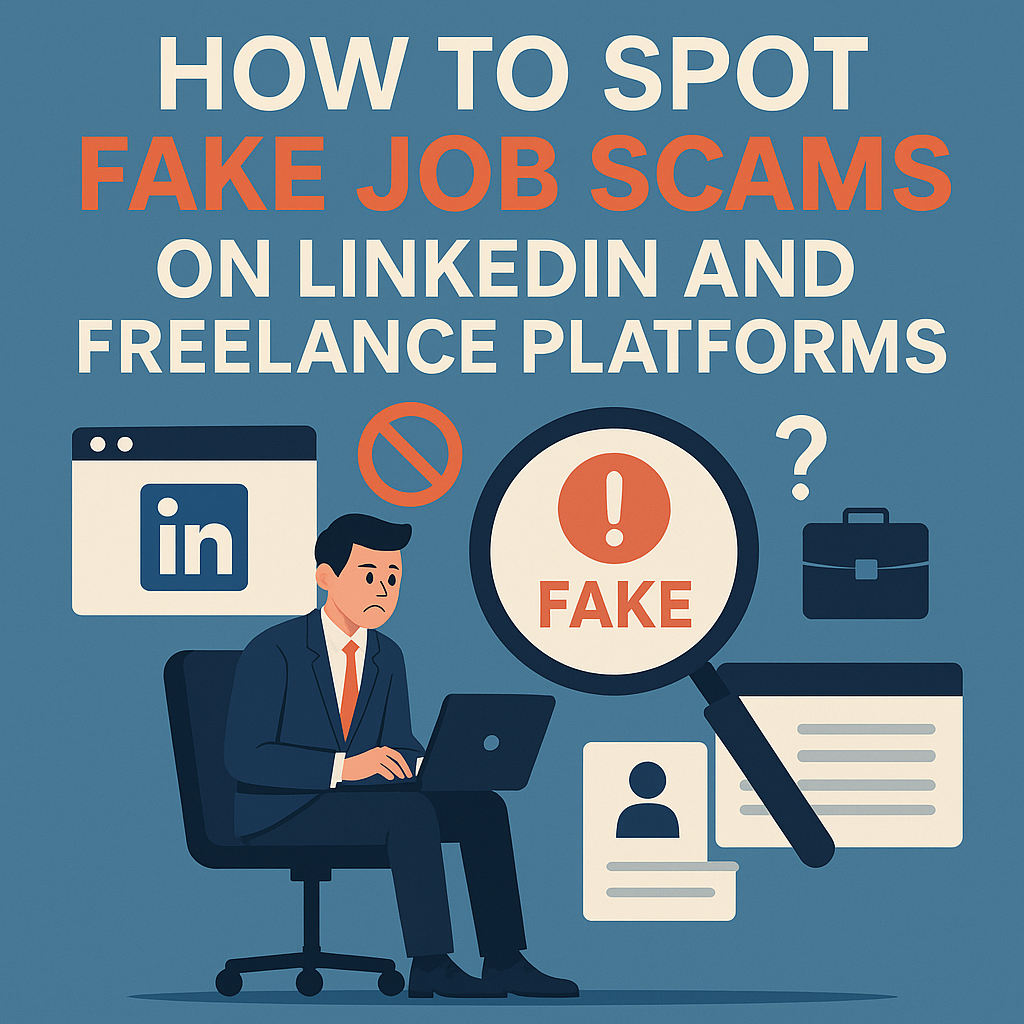
Table of Contents
If you’re looking for remote work, knowing how to spot fake job scams on LinkedIn and freelance platforms can protect you from costly mistakes. In 2025, scammers are targeting U.S. freelancers and job seekers more aggressively than ever. They create professional-looking job posts to trick you into sharing personal information or sending money. By learning how to identify these scams early, you can keep your online career safe.
Fraudsters prey on hope and urgency, offering quick money or exclusive opportunities. The sad reality is that many victims don’t realize they’ve been scammed until it’s too late. That’s why spotting fake job scams on LinkedIn and freelance platforms is a critical skill for 2025.
Why Fake Job Scams Are Growing in 2025
Remote work and freelancing continue to grow in the U.S., giving scammers more opportunities. According to the Federal Trade Commission (FTC), thousands of Americans report job scams every year, many losing hundreds or even thousands of dollars. The scams often promise easy income, but the end goal is always the same: trick you into sending money or sharing personal information.
Common Red Flags of Fake Job Scams on LinkedIn
Spotting fake job scams on LinkedIn can be tricky since scammers often pose as real recruiters. Here are warning signs to watch for:
- Too-good-to-be-true offers: Jobs promising high pay for little work are major red flags.
- No video calls or interviews: Scammers often avoid face-to-face communication.
- Suspicious company profiles: If the company has no website, reviews, or LinkedIn history, proceed with caution.
- Requests for upfront fees: No legitimate employer will ask you to pay for training, software, or application processing.
Fake Job Scams on Freelance Platforms
Freelance platforms like Upwork, Fiverr, and Freelancer.com aren’t immune. Here’s how fake job scams on freelance platforms usually work:
- Clients avoiding escrow systems: They insist on paying you outside the platform.
- Fake payment confirmations: You complete work, but the payment never arrives.
- Upfront payment requests: Clients asking you to “invest” in tools or pay deposits.
- Unrealistic promises: Large projects offered to new freelancers with no reviews.
How to Protect Yourself from Fake Job Scams
U.S. freelancers can take practical steps to avoid falling for fake job scams on LinkedIn and freelance platforms:
- Verify the employer: Check the company on LinkedIn and cross-reference with the Better Business Bureau (BBB).
- Communicate through official channels: Stick to platform messaging systems until trust is established.
- Never send upfront payments: Legit employers cover business expenses.
- Use secure payment methods: On freelance platforms, always use escrow or verified payment systems.
- Trust your instincts: If something feels off, it probably is.
Real Examples of Fake Job Scams
To understand the danger, here are common examples U.S. freelancers have reported:
- The Check Scam: You’re sent a “check” to buy equipment, asked to send the leftover funds back. The check later bounces.
- Phishing Job Offer: You receive a message asking for your Social Security number or bank details “for verification.”
- Fake Company Page: Scammers create a LinkedIn page that looks like a real business but has no verified employees.
- Data Entry Fraud: They hire you for easy tasks, then ask you to pay a deposit for “training software.”
Each of these shows why it’s so important to recognize fake job scams on LinkedIn and freelance platforms before you engage.
Reporting Fake Job Scams in the USA
If you come across a suspicious job posting, don’t just ignore it—report it. This helps protect other freelancers and job seekers.
- File a report at the FTC’s ReportFraud website.
- Read the FTC Job Scams Warning for the latest scam alerts.
- Report fraudulent companies through the Better Business Bureau Scam Tracker.
The more people report, the harder it becomes for scammers to keep targeting honest freelancers.
Future Trends in Job Scams 2025: What U.S. Freelancers Should Know
As technology advances, so do the tactics of scammers. In 2025, fake job scams on LinkedIn and freelance platforms are expected to become even more sophisticated. Cybercriminals are increasingly using AI-generated job postings and chatbots that mimic real recruiters, making scams harder to detect. Some are even creating fake video interviews using deepfake technology to build trust with U.S. job seekers.
Freelancers should also be aware of crypto-related job scams, where fake employers promise payment in cryptocurrency but disappear after receiving work. Another growing trend is phishing through LinkedIn InMail, where scammers send convincing messages that appear to come from legitimate companies.To stay safe, U.S. freelancers must combine technology with vigilance — using trusted security tools, verifying recruiters, and staying informed through resources like the FTC Job Scams Warning and the BBB Scam Tracker.
Final Thoughts on How to Spot Fake Job Scams on LinkedIn and Freelance Platforms
In 2025, freelancing and remote work are booming—but so are online scams. Knowing how to spot fake job scams on LinkedIn and freelance platforms gives you the power to protect your career. Always verify job offers, use secure payment systems, and report scams when you see them.
The best defense is awareness. Share this guide with fellow freelancers and stay one step ahead of scammers.
✅ Quick Takeaway
Scams thrive on urgency and secrecy. Slow down, verify, and use trusted platforms to avoid becoming the next victim.
You may also like our guide on How to Secure Your Wi-Fi Network From AI Snooping Tools (2025 Guide)
FAQs: How to Spot Fake Job Scams on LinkedIn and Freelance Platforms
Q1: How can I tell if a LinkedIn job offer is a scam?
Look for vague job descriptions, unverified recruiters, and requests for upfront fees. Always verify the company on LinkedIn and check their website for legitimacy.
Q2: Are there common signs of fake job scams on freelance platforms?
Yes. Scammers often try to take conversations off the platform, send fake payment receipts, or offer unrealistically high pay for little work.
Q3: What should I do if I suspect a fake job scam in the USA?
Report it immediately to the FTC’s ReportFraud website and the BBB Scam Tracker. Also flag the post directly on LinkedIn or your freelance platform.
Q4: Do scammers really target U.S. freelancers?
Absolutely. With remote work booming, U.S. freelancers are prime targets for fake job scams on LinkedIn and freelance platforms because scammers know many are eager for opportunities.
Q5: Can I get my money back after falling for a job scam?
Unfortunately, recovering money is very difficult. However, reporting quickly to your bank, PayPal, or credit card company can sometimes stop fraudulent transactions.
Q6: How can I avoid fake job scams in 2025?
Stick to verified employers, use escrow systems on freelance platforms, and never share personal or financial details until you confirm the company is legitimate.

Pingback: Best Browsers for Privacy in 2025 | Chrome vs Brave vs Firefox